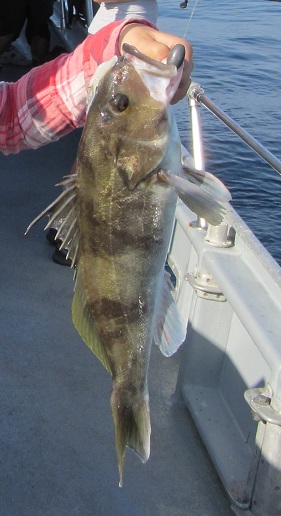Barred sand bass
 Barred sand bass range from Bahia Magdalena, Baja California Sur to Santa Cruz, California (with a notable report in Acapulco, Mexico), but are also found primarily between Baja California Norte and Point Conception, California. They prefer relatively shallow depths in sand/mud flat areas adjacent to rocky reefs and kelp beds, as well as in bays, harbors, and estuaries. Barred sand bass have similar growth to kelp bass. They are mature at 3-4 years old (or about 10 inches), and legal sized fish (14 inches) are typically about 8 years old. Individuals have been aged to 31 years old. Juveniles feed primarily on small invertebrates, while adults feed primarily on small fishes, market squid, and other invertebrates. Similarly to kelp bass, their diel movement patterns show relatively small home ranges and strong site fidelity, although this species makes annual spawning migrations that have been measured up to 35 km (about 22 miles). Barred sand bass spawn during the day, approximately every 2 ½ days in both July and August in large aggregations (probably thousands of individuals, or more) that occur in the same areas every summer (e.g. Ventura flats, Huntington flats, Dana Point, and Imperial Beach). There appears to be strong spawning site fidelity among individuals, but fish from the same non-spawning areas do not necessarily migrate to the same spawning aggregations. Nonetheless, this highly predictable aggregating behavior makes them very susceptible to overfishing during the spawning season. There was a commercial fishery for barred sand bass that was closed in 1953 (similar to kelp bass), after which time the recreational fishery grew for several decades. However, recreational landings abruptly declined around 2005-2006, and have remained at these depressed levels since. The California Department of Fish and Game is currently addressing potential changes in the regulations for this fishery in an effort to reverse this recent decline.
Barred sand bass range from Bahia Magdalena, Baja California Sur to Santa Cruz, California (with a notable report in Acapulco, Mexico), but are also found primarily between Baja California Norte and Point Conception, California. They prefer relatively shallow depths in sand/mud flat areas adjacent to rocky reefs and kelp beds, as well as in bays, harbors, and estuaries. Barred sand bass have similar growth to kelp bass. They are mature at 3-4 years old (or about 10 inches), and legal sized fish (14 inches) are typically about 8 years old. Individuals have been aged to 31 years old. Juveniles feed primarily on small invertebrates, while adults feed primarily on small fishes, market squid, and other invertebrates. Similarly to kelp bass, their diel movement patterns show relatively small home ranges and strong site fidelity, although this species makes annual spawning migrations that have been measured up to 35 km (about 22 miles). Barred sand bass spawn during the day, approximately every 2 ½ days in both July and August in large aggregations (probably thousands of individuals, or more) that occur in the same areas every summer (e.g. Ventura flats, Huntington flats, Dana Point, and Imperial Beach). There appears to be strong spawning site fidelity among individuals, but fish from the same non-spawning areas do not necessarily migrate to the same spawning aggregations. Nonetheless, this highly predictable aggregating behavior makes them very susceptible to overfishing during the spawning season. There was a commercial fishery for barred sand bass that was closed in 1953 (similar to kelp bass), after which time the recreational fishery grew for several decades. However, recreational landings abruptly declined around 2005-2006, and have remained at these depressed levels since. The California Department of Fish and Game is currently addressing potential changes in the regulations for this fishery in an effort to reverse this recent decline.
